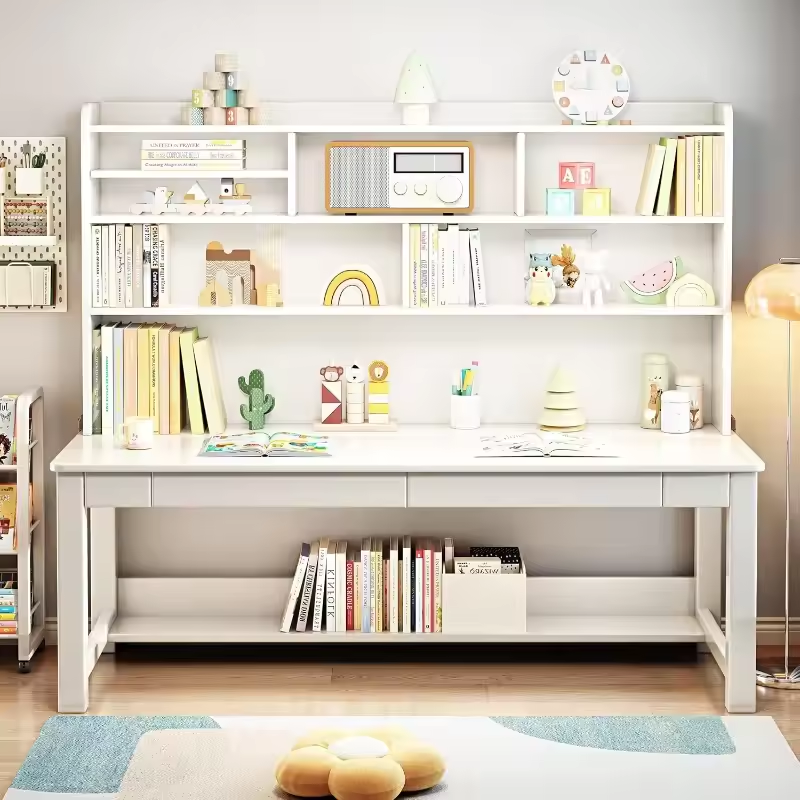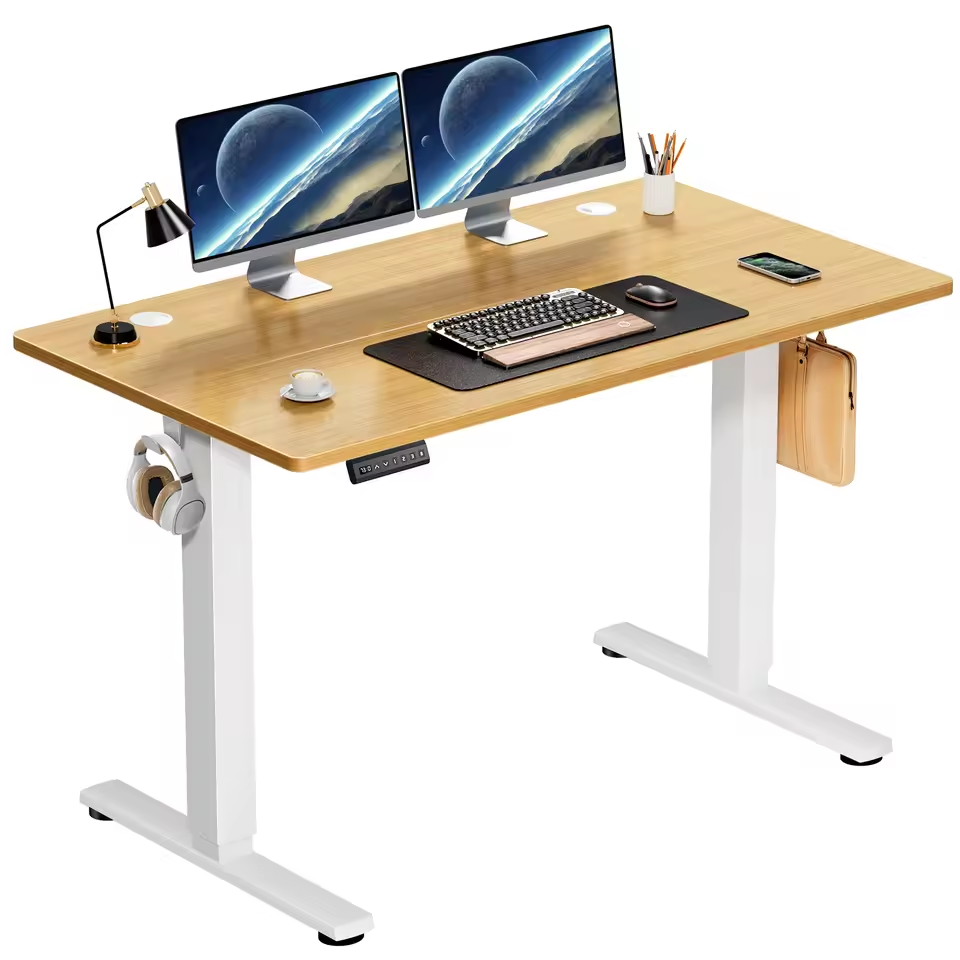Considerations for a Sibling-Friendly Desk Area
When planning a desk for two kids, it’s essential to consider each child’s needs. A sibling-friendly study space fosters harmony and productivity. The key lies in balancing private and shared areas. Start by choosing a location that is quiet and has enough light. Ensure the desk fits the room without crowding it. Think about accessibility to power outlets for their devices. Safety is vital, so look for a desk with rounded corners. Finally, consider the future – the desk should grow with your children. Keep these considerations in mind to create a functional and pleasant study area for your kids.

Creating a shared workspace for siblings requires thoughtful design to address both collective and individual needs. Here are key elements to consider:
- Determine the Size: Select a desk size that allows enough room for both children. They should be able to work without bumping elbows.
- Zone Division: Ideally, the desk for two kids should have a clear division. This can be a physical barrier or designated zones to give each child their own space.
- Flexibility: Consider desks with adjustable features. This will accommodate their different activities and growth spurts.
- Aesthetics: Choose a design that appeals to both kids. It should fit well with the room’s decor and be age-appropriate.
- Shared Resources: Ensure there is enough space to house shared resources like a printer or art supplies, to promote collaboration.
- Accessibility: Items that both kids need should be easily accessible from both sides of the desk.
By focusing on these key design principles, you can establish a conducive environment for your children to learn and grow together. Selecting the right desk and layout promotes a sense of individuality while also encouraging teamwork and shared responsibility in their study space.
Desk Options Suitable for Siblings
When choosing a desk for two kids, options can vary widely. Aim for desks that are durable, have easy-to-clean surfaces, and offer plenty of room for each child. Here are some suggestions:
- T-shaped or L-shaped Desks: These desks provide distinct workspaces for each sibling while still maintaining closeness for joint activities.
- Long Rectangular Desk: A single, lengthy desk with space for two chairs means shared space but with personal zones.
- Back-to-Back Desks: Position two desks back-to-back to create a sense of separation with each child facing away from the other.
- Desks with a Hutch: Desks with built-in storage or a hutch help keep supplies organized and within easy reach.
- Height-Adjustable Desks: Desks with adjustable heights cater to the growing needs of children, ensuring ergonomic comfort as they grow.
Ensuring that the desk fits well in the available space and allows for easy movement, is critical. Look for options that can incorporate cable management systems to avoid clutter. Additionally, desks that come with accessories such as bookshelves or side drawers increase functionality and help maintain a tidy area. Opt for quality materials that can withstand the wear and tear of daily use. By selecting the right desk design, you foster a productive atmosphere for your children’s studies and projects.
Storage Solutions for Sibling Desk Setups
When setting up a desk for two kids, efficient storage solutions are crucial to keep the space organized and ensure that there’s a place for everything. Here’s how to make the most out of the workspace:
- Use Vertical Space: Mount shelves above the desk to store books, stationery, and other supplies, maximizing the use of vertical space.
- Desk Organizers: Invest in desk organizers for pens, pencils, and small items. These can be shared or individual, depending on the needs.
- Under-Desk Storage: Opt for desks with built-in drawers or add separate filing cabinets underneath to store papers and larger items.
- Wall Organizers: Hang organizers on the wall within arm’s reach for easy access to frequently used items.
- Cubbies or Bins: Place cubbies or colored bins nearby to categorize and store different types of items, like art supplies or electronics.
- Shared Supply Station: Create a central area on or near the desk where siblings can store and share communal items.
- Label Everything: Label drawers, bins, and shelves. This helps kids find things quickly and encourages them to put things back.
- Personal Boxes: Give each child a personal box for items they don’t want to share. This respects their individual ownership.
Implementing these storage solutions will help maintain order and tranquility in a shared desk space, allowing your kids to focus on their studies without being distracted by clutter.
When designing a desk for two kids, ergonomics and comfort take center stage. Here are practical tips to ensure both:
- Adjustable Chairs: Invest in chairs that adjust in height. These cater to the children’s different sizes and grow with them.
- Proper Lighting: Make sure each child has ample light. Individual lamps can help prevent eye strain.
- Footrests: If chairs are too high, use footrests to support the kids’ feet, promoting proper posture.
- Wrist Rests: Provide wrist rests to prevent strain from writing or typing for long periods.
- Monitor Height: If using computers, the top of the screen should be at eye level to avoid neck pain.
- Spacing: Ensure kids have enough room to stretch their legs without hitting each other.
- Personal Comfort Items: Allow each child to have a cushion or throw blanket for extra comfort.
By incorporating these ergonomic elements, you help prevent discomfort and foster a conducive learning environment in a shared study space.
Creative Ways to Personalize Each Child’s Space
Creating a desk for two kids should not only be about functionality but also about personalization. Here are some creative ways to help each sibling make their desk area their own:
- Color Coding: Assign a different color for each child’s area. Use this color for their chair, desk accessories, or even the trim of their desk.
- Personal Display: Allow each child to have a small space to display personal items, such as a pinboard or a picture frame.
- Choice of Accessories: Let kids choose their own desk organizers and stationery. This gives them a sense of control and ownership.
- Unique Lighting: Individual desk lamps not only provide necessary lighting but also add a personal touch if chosen by each child.
- Name Plaques: Put name plaques on their desk or chair. This simple sign can make a big difference in how they perceive their individual spaces.
- DIY Decor: Encourage the children to create their own DIY decor to adorn their desk areas. Perhaps they could make a pencil holder or a calendar.
- Themed Elements: If they are interested, use themed elements based on their favorites, like animals, sports, or outer space, to decorate their areas.

Incorporating these personal touches ensures that even though the children are sharing a desk, they still have a space that feels uniquely theirs. This can greatly contribute to their comfort and happiness while using the desk.
Technology Considerations for a Two-Person Desk
In planning a desk for two kids, integrating technology is key for today’s learning. Here are factors to consider:
- Power Outlets: Ensure easy access to multiple power outlets for charging devices.
- Technology Storage: Provide space for laptops, tablets, and other tech when not in use.
- Cable Management: Install cable organizers to keep wires neat and prevent tangling.
- Tech Sharing: Place shared tech like printers in a central location for both to use.
- Internet Access: Set up a reliable Wi-Fi network that reaches the desk area for online tasks.
- Headphone Hooks: Add hooks or stands for storing headphones when they are not needed.
- Ergonomic Accessories: Consider stands or pads that elevate devices to eye level.
By addressing these technology needs, you create a functional and efficient workspace for two.
Creating an effective desk for two kids involves more than just choosing furniture. It’s important to maintain privacy and minimize distractions, especially in a shared space. Here are tips to help siblings focus and feel a sense of personal space:
- Privacy Screens: Add privacy screens between the desks. This allows for concentration and reduces visual distractions.
- Headphones: Encourage the use of headphones for listening to music or online classes. This cuts down on noise.
- Study Hours: Set specific ‘quiet hours’ when both children are at the desk to foster a routine of focused study time.
- Separate Storage: Use separate drawers or shelves for each child’s personal items. This avoids mix-ups and maintains order.
- Visual Boundaries: Define clear visual boundaries with different desk mats or colored tape. This marks personal territory subtly.
- Room Layout: Position the desk so that distractions from windows or the room’s entrance are minimized for both children.
- Work Schedules: If possible, arrange different work schedules. One child studies while the other takes a break, reducing distractions.
By implementing these strategies, each child can enjoy a bit of privacy and an environment that helps them concentrate on their work. A well-maintained shared desk setup can improve productivity and harmonious sibling relationships.